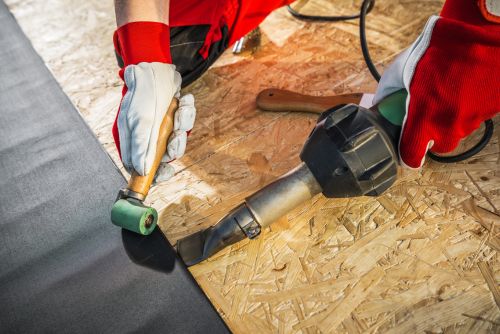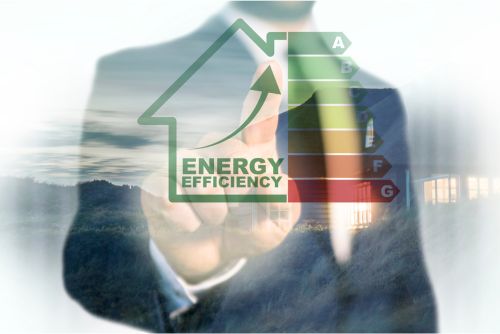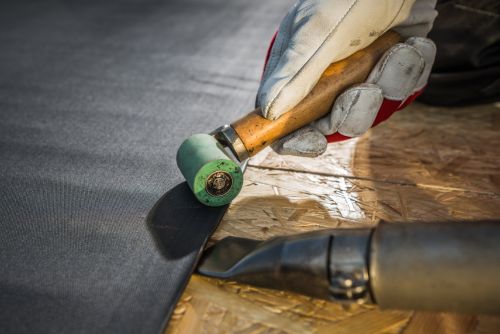
When it comes to choosing the right roofing material for your flat roof, several factors come into play. One important consideration is the cost of the roofing material and installation. In this blog, we will compare two popular options: EPDM and TPO roofing. EPDM, which stands for ethylene propylene diene monomer, is a synthetic rubber roofing membrane, while TPO, or Thermoplastic Olefin, is a roofing membrane made from a blend of polypropylene and ethylene-propylene rubber. Both materials have their own advantages and disadvantages, and understanding the cost differences between EPDM and TPO roofing can help you make an informed decision for your roofing needs. So, which is cheaper EPDM or TPO? Let us find out!
TPO roofing, short for thermoplastic polyolefin, has gained popularity in the roofing industry in recent years. This roofing membrane was first introduced in the 1980s and quickly became a popular choice for flat roofing systems in commercial buildings. TPO roofing systems are known for their durability, energy efficiency, and ease of installation. The material is available in wide rolls, making it more efficient to install, and its track record of energy efficiency has made it a top choice for business owners.
TPO roofing systems first emerged in the roofing industry in the 1980s, offering a new and improved roofing material for flat roofs. With its track record of durability, insulation, and energy efficiency, TPO systems quickly gained popularity among roofing contractors and business owners alike. The wide rolls of TPO roofing material allowed for more efficient installation, making it a cost-effective choice for commercial buildings with large flat roof areas. Over the years, TPO roofing has proven itself as a reliable and long-lasting option, making it a popular choice in the roofing industry.
TPO roofing offers several benefits for business owners looking for a durable and energy-efficient roofing system. Here are some of the advantages of using TPO roofing:
While TPO roofing has many benefits, there are some downsides to consider as well. Here are a few things to keep in mind:

EPDM roofing, short for ethylene propylene diene monomer, is a type of synthetic rubber roofing material. It has been used in the roofing industry since the 1960s and is known for its durability and longevity. EPDM roofing membranes come in black or white and are commonly used for flat roofing systems in commercial buildings. They offer excellent insulation properties, weather resistance, and ease of installation, making them a popular choice for business owners seeking a cost-effective and reliable roofing solution.
EPDM roofing material has been a popular choice in the roofing industry since it first emerged in the 1960s. The roofing material, made of ethylene propylene diene monomer, quickly gained recognition for its durability and track record of performance. EPDM systems became a go-to choice for business owners looking for a cost-effective roofing material that could withstand different weather conditions. Roofing contractors appreciate EPDM roofing material for its ease of installation, and it continues to be a popular option for commercial buildings with flat roofs.
EPDM roofing offers several advantages for business owners considering flat roofing systems. Here are some of the benefits of using EPDM roofing:
While EPDM roofing has many advantages, it’s important to be aware of potential problems that may arise. Here are some considerations:

The cost of roofing materials and installation is an important consideration for business owners. When comparing TPO and EPDM roofing, it’s important to consider both material costs and installation costs. Material costs can vary based on factors such as square footage and the type of roofing system, while installation costs depend on factors such as labor costs and the complexity of the installation process. Understanding which is cheaper EPDM or TPO roofing can help business owners make an informed decision about which option best suits their budget and roofing needs.
TPO roofing material costs are typically budget-friendly, making it an attractive option for business owners looking for cost-effective roofing solutions. The cost of TPO membrane varies based on factors such as the type of system, thickness, and quality of the material. On average, TPO material costs range from $0.80 to $1.50 per square foot, depending on the supplier and specific product. It’s important to note that material costs alone do not reflect the total cost of a roofing project. Other factors such as installation costs, warranties, and long-term maintenance should also be considered when evaluating the overall cost of TPO roofing.
The installation costs of TPO roofing vary depending on factors such as the complexity of the roof, labor costs in your area, and the experience of the commercial roofing contractor NJ. On average, installation costs for TPO roofing range from $4.50 to $8.50 per square foot. It’s important to hire a professional roofing contractor with experience installing TPO roofing systems to ensure a proper installation and maximize the lifespan of your roof. A professional contractor can provide an accurate estimate of the installation costs based on the specific requirements of your project.
When considering the cost of TPO roofing, it’s important to factor in the lifespan and maintenance costs. TPO roofing systems typically have a lifespan of 20+ years when properly installed and maintained. The longevity of TPO roofing can help reduce long-term maintenance costs compared to other roofing materials. Regular inspections and maintenance, such as clearing debris from drains and ensuring proper seals around penetrations, are important for maximizing the lifespan of your TPO roof. Additionally, warranties provided by the roofing material manufacturer should be considered, as they can provide added peace of mind and potential cost savings in case of material defects.
EPDM roofing material costs can vary based on factors such as thickness, type of membrane, and supplier. On average, EPDM material costs range from $0.80 to $1.50 per square foot, making it a cost-effective option for business owners. It’s important to consider material costs alongside other factors such as installation costs, longevity, and warranties when evaluating the overall cost of EPDM roofing for your project.
The installation costs of EPDM roofing can vary depending on factors such as the complexity of the roof, labor costs in your area, and the experience of the commercial roofing company NJ. On average, installation costs for EPDM roofing range from $4.50 to $8.50 per square foot. Hiring a professional roofing company with experience installing EPDM roofing systems is important to ensure a proper installation and maximize the lifespan of your roof. A professional contractor can provide an accurate estimate of the installation costs based on the specific requirements of your project.
EPDM roofing systems have a lifespan of up to 30 years when properly installed and maintained. The longevity of EPDM roofing can help reduce long-term maintenance costs and commercial roof replacement NJ compared to other roofing materials. While EPDM roofing requires minimal maintenance, regular inspections and basic upkeep, such as clearing debris from drains and ensuring proper seals, are important for maximizing the lifespan of your roof. Additionally, warranties provided by the roofing material manufacturer should be considered, as they can provide added peace of mind and potential cost savings in case of material defects.

Energy efficiency is an important consideration when choosing a roofing material, as it can impact cooling and heating costs. Both TPO and EPDM roofing systems offer energy-efficient solutions for business owners. TPO roofing, especially in white, reflects UV rays and reduces cooling costs during warmer months. EPDM roofing, on the other hand, provides insulation and energy efficiency, reducing heating costs during colder months. Understanding how TPO and EPDM roofing contribute to energy efficiency can help business owners make an informed decision based on their climate and energy consumption needs.
One of the ways TPO roofing contributes to energy efficiency is through its white color, which reflects UV rays. This reflective property helps reduce cooling costs, especially during warmer months. By reflecting the sun’s heat, TPO roofing systems can keep buildings cooler, minimizing the need for excessive air conditioning. The energy efficiency of TPO roofing material makes it a popular choice for business owners looking to reduce cooling costs and lower their environmental impact. It’s important to note that TPO roofing’s energy efficiency benefits can vary based on factors such as climate, insulation, and proper installation.
EPDM roofing contributes to energy efficiency in several ways. While black EPDM roofing membranes absorb heat, white EPDM roofing is also available, which reflects the sun’s heat. Both black and white EPDM roofs offer insulation properties that help regulate temperature, reducing heating costs during colder months. In warmer months, black EPDM roofing systems can actually absorb heat, potentially reducing cooling costs. The choice of color for EPDM roofing material depends on your climate, energy consumption needs, and aesthetic preferences. Consulting with a roofing professional can help you determine the best option for your business.
The aesthetics of a roofing system can play a significant role, particularly in commercial buildings. TPO and EPDM roofing systems have different visual characteristics that may appeal to different business owners. TPO roofing, often white in color, offers a modern and clean aesthetic, which can complement various architectural styles. EPDM roofing, available in black or white, provides a different look, with black EPDM being a popular choice for commercial buildings. The choice of roofing material should consider both durability and aesthetic appeal, ensuring that it suits the overall design of the building and meets the business owner’s preferences.
TPO roofs, often white in color, offer a clean and modern appearance, making them popular for flat roofing systems in commercial buildings. The white color of TPO roofing membranes enhances the overall aesthetics of a building, creating a sleek and professional look. TPO roofing material, with its wide rolls and heat-welded seams, provides a seamless appearance, minimizing the visibility of fasteners and penetrations. The appearance of TPO roofs can complement various architectural styles, making it a popular choice among business owners seeking both durability and visual appeal. Additionally, TPO roofing material is made of polyvinyl chloride (PVC), which adds to its durability and longevity.
EPDM roofing systems come in black or white, each offering its own unique appearance. Black EPDM roofs are commonly used in commercial buildings, while white EPDM roofing membranes are also available. The choice of color depends on factors such as climate, energy efficiency needs, and personal preference. Black EPDM roofing material, with its wide rolls and fewer seams, provides a clean and smooth appearance, making it a popular choice for commercial buildings. EPDM roofing material, especially in black, has a strong track record and is also well-suited for residential flat roofs, offering durability and insulation.

Choosing between TPO and EPDM roofing should consider several factors, including the local climate and type of roof. TPO roofing, with its energy efficiency benefits and durability, may be the best choice for business owners looking to reduce cooling costs in warmer climates. EPDM roofing, with its longevity, insulation, and track record, is well-suited for residential flat roofs and commercial buildings. It’s important to assess your climate, energy efficiency needs, and roofing requirements to determine the best option for your business.
The type of roof and local climate are important considerations when choosing between TPO and EPDM roofing. TPO roofing systems, with their white color and energy efficiency, are particularly well-suited for commercial buildings, especially in warmer climates. EPDM roofing, known for its durability and insulation, is a popular choice for residential flat roofs and commercial buildings, offering longevity and performance in varying local climates. Consulting with roofing professionals can help business owners assess the specific requirements of their roof type and local climate, ensuring they choose the option that best suits their needs.
Deciding which is cheaper EPDM or TPO roofing involves evaluating costs and value for business owners. Both roofing materials offer cost-effectiveness, durability, and energy efficiency benefits, but the best choice depends on individual business needs and budget considerations. EPDM roofing can provide long-term value due to its longevity and minimal maintenance requirements. TPO roofing, with its energy efficiency and lower material costs, may be a more affordable option upfront. Business owners should consider factors such as lifespan, warranties, cooling costs, heating costs, and installation requirements to determine the best roofing material that offers a cost-effective solution for their specific needs.
In conclusion, when deciding between TPO and EPDM roofing, it’s important to consider factors such as the material costs, installation costs, lifespan, maintenance costs, energy efficiency, and aesthetic differences. TPO roofing offers benefits such as high reflectivity and heat resistance, while EPDM roofing is known for its durability and flexibility. Both options have their pros and cons, so it’s crucial to assess your specific needs and budget before making a decision. Ultimately, the choice between TPO and EPDM depends on your individual circumstances and preferences. If you’re unsure which option is right for you, consult with a roofing professional who can provide expert advice tailored to your situation.